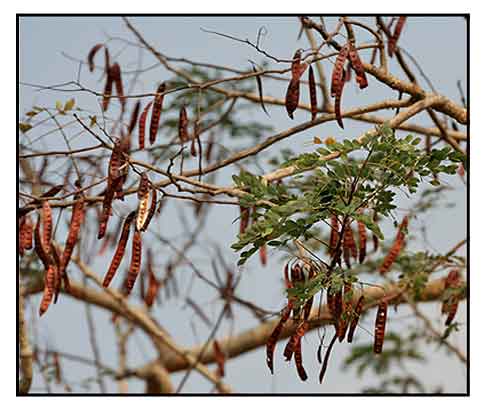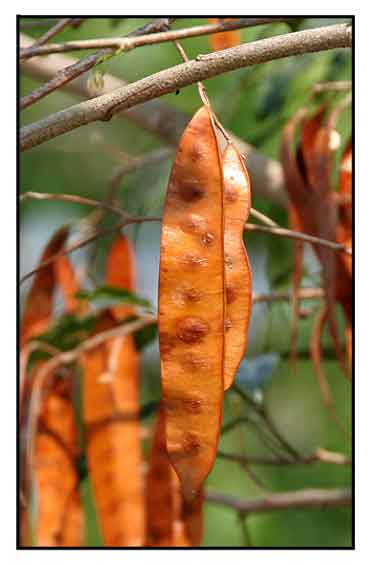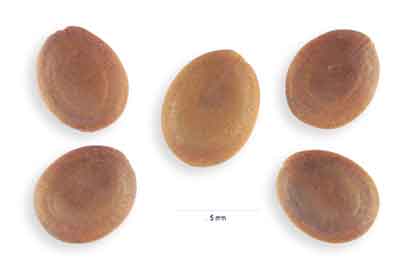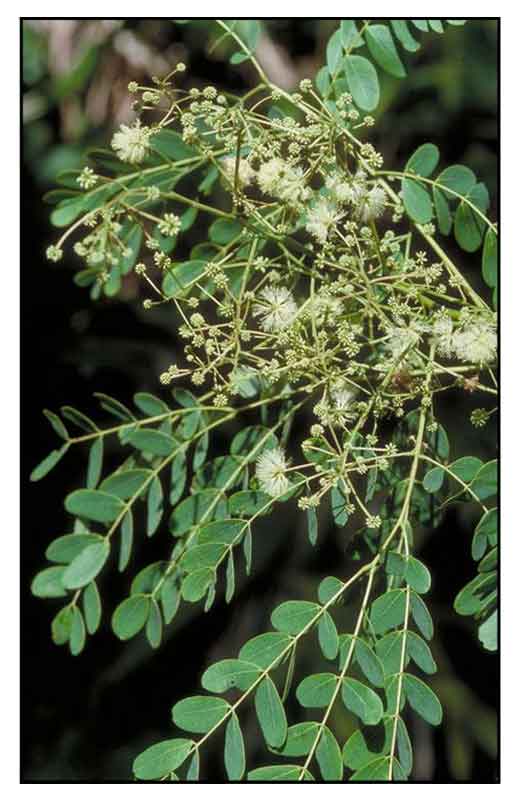 Gen info Gen info
- Albizia is a genus of more than 160 species of mostly fast-growing subtropical and tropical trees and shrubs in the subfamily Mimosoideae of the family Fabaceae. They are commonly called silk plants, silk trees, or sirises.
-
Genus nae Albizia honors the Florentine naturalist Filippo degli Albizzi, while the species epithet derives from the Latin word 'procerus', meaning 'very tall or high'. (4)
Botany
Albizia procera is a tree with an open canopy, up to 30 m tall with trunk of 35(-60) cm in diameter; bole straight or crooked, up to 9 m. Bark smooth, pale grey-green, yellowish-green, yellowish-brown or brownish with horizontal ridges, sometimes flaking in thin, small scales, underbark green, changing to orange just below the surface, inner bark pinkish or straw-coloured. Branchlets terete, glabrous. Leaves bipinnate with 2-5 pairs of subopposite pinnae; rachis 10-30 cm, glabrous, with a gland 1-2.5 cm above the base; gland narrowly elliptical, 4-10 mm long, sessile, flat and disc-like or concave with raised margins; pinnae 12-20 cm long, glabrous, with elliptical glands below the junction of the 1-3 distal pairs of petiolules, 1 mm in diameter; petiolule 2 mm; leaflets 5-11 pairs per pinna, opposite, rigidly chartaceous to subcoriaceous, asymmetrically ovate to sub-rhomboid, 2-4.5(-6) cm × 1-2.2(-3.2) cm, base asymmetrical, half truncate, half cuneate, apex rounded or subtruncate, often emarginate, mucronate, both surfaces sparsely appressed puberulous, rarely glabrous above. Inflorescence composed of pedunculate glomerules collected in an axillary, sparsely puberulous panicle up to 30 cm long; peduncle (0.8-)1.5-2(-3) cm long, 2-5 together. Flowers 15-30 per glomerule, sessile, uniform (central flowers usually larger than marginal ones), bisexual, pentamerous; calyx tubular to narrowly funnel-shaped, 2.5-3 mm, glabrous, light green, teeth triangular, 0.75-1.2 mm, acute; corolla funnel-shaped, 6-6.5 mm long, greenish-white, tube glabrous, with elliptical lobes of 2-2.5 mm, acute, puberulous at the apex; stamens numerous, united at the base into a tube that is longer than the corolla tube; ovary glabrous. Pod straight, flat, chartaceous, 11.5-20 cm × 2-2.5 cm, glabrous, dark or red-brown, with distinct marks over the seeds, dehiscent. Seed flattened obovoid-ellipsoid, 7.5-8 mm × 4.5-6.5 mm × 1.5 mm; areole 4.5 mm × 3 mm with pleurogram nearly parallel to the margins of the seed. Seed with epigeal germination. (PROSEA) (2)
 A. procera is typically between 7 and 15 meters tall, although occasionally it reaches 30 meters in height. It is deciduous, going leafless in the dry season (August-September). The leaves are bi-pinnate, with 2-5 pairs of sub-opposite pinnae and a 10-30 centimeter rachis. The bark is smooth and light-colored, exfoliating to reveal a reddish color underneath. It produces sessile greenish-yellow flowers with long, threadlike white stamens, creating a puffball effect; these are borne on racemes 8-25 centimeters long. The flowers give way to rich red or reddish-brown flattened pods containing 6-12 small, greenish-brown seeds. (4) A. procera is typically between 7 and 15 meters tall, although occasionally it reaches 30 meters in height. It is deciduous, going leafless in the dry season (August-September). The leaves are bi-pinnate, with 2-5 pairs of sub-opposite pinnae and a 10-30 centimeter rachis. The bark is smooth and light-colored, exfoliating to reveal a reddish color underneath. It produces sessile greenish-yellow flowers with long, threadlike white stamens, creating a puffball effect; these are borne on racemes 8-25 centimeters long. The flowers give way to rich red or reddish-brown flattened pods containing 6-12 small, greenish-brown seeds. (4)
Distribution
- Native to the Philippines.
- Also native to Andaman Is., Assam, Bangladesh, Bismark Archipelago, Borneo, Cambodia, China, Hainan, Himalaya, India, Jawa, Laos, Lesser Sunda Is., Malaya, Maluku, Myanmar, Nepal, New Guinea, Norther Territory, Queensland, Solomon Is., Sri Lanka, Sulawesi, Sumatera, Taiwan, Thailand, Vietnam, Western Australia. (1)
- Grows primarily in the wet tropical biome(s).
- In South Africa, considered an invasive species.
- In Cuba, Dominican Republic, Puerto Rico and Virgin Islands, it is an aggressive colonizer of abandoned farmlands, pastures roadsides, and other highly disturbed areas. (26)
 Constituents Constituents
- Phytochemical screening of leaf extracts yielded saponins, steroids, tannins, glycosides, and flavonoids. Ethyl acetate extract showed highest total phenolic content (449.18 mg GAE/g extract. (see study below) (5)
- Bioassay-guided study of EA fraction of bark isolated two compounds, (+)-catechin (1) and protocatechuic acid (2).
(see study below) (7)
- GC-MS analysis of aerial parts yielded 12 compounds namely: 3-O-methyl-d-glucose (55.38%), 1,10-decanediol (2.31%), 3-pentanol, 2,3-dimethyl- (0.26%), decanoic acid, ethyl ester (1.54%), phytol (3.33%), 1-undecyne
(0.77%), didodecyl phthlate (2.56%), squalene (6.15%), 9,12-octadecadienoic acid (Z,Z)-,phenylmethyl ester (3.85%), 6,9,12-octadecatrienoic acid, phenylmethyl ester (Z,Z,Z)- (4.87%), benzo[b]thiophene-2-carboxamide,3-chloro-N-(4-methoxyphenyl) (8.97%), 13-tetradece-11-yn-1-ol (10.00%). (9)
- Study of A. procera gum for monosaccharide composition and physicochemical properties revealed a reddish brown crude exudate gum with fairly good flow property
. High performance anion exchange chromatography for monosaccharides yielded arabinose (44.94%), galactose (30.17%), rhamnose (0.22%) and fructose (0.02%). (13)
- Study isolated a trisaccharide related to the cytotoxic triterpenoid saponins from the bark of Albizia procera. (18)
- Study of bark isolated three new (1,2,4) and one known (3) triterpenoid saponins, characterized ass 3-O-[β-d-xylopyranosyl-(1 → 2)-α-l-arabinopyranosyl-(1 → 6)-2-acetamido-2-deoxy-β-d-glucopyranosyl] echinocystic acid (1), 3-O-[α-l-arabinopyranosyl-(1 → 2)-β-d-fucopyranosyl-(1 → 6)-2-acetamido-2-deoxy-β-d-glucopyranosyl] echinocystic acid (2) and 3-O-[β-d-xylopyranosyl-(1 → 2)-α-l-arabinopyranosyl-(1 → 6)-2-acetamido-2-deoxy-β-d-glucopyranosyl] acacic acid lactone (4). (see study below) (21)
- Study isolated compound (1) 2,2- dimethylvinyl methyl ketone and compound (2) 2,6,10,15,19,23-Hexamethyl-2,6,10,14,18,22-tetracosahexene (C30H50) from hexane and ethyl acetate fraction of Albizia procera. (see study below) (24)
- Study of methanolic extract of leaves isolated the flavonoids luteolin, quercetin-3-O-α-L-rhamnopyranoside, quercetin-3-O-β- D-galactopyranoside, quercetin-3-O-β-D-glucopyranoside and quercetin-3-O-(2”- O-β-D-xylopyranosyl)-β-D-galactopyranoside. (29)
Properties
- Studies have suggested antioxidant, anti-HIV integrase, antibacterial, analgesic, anti-inflammatory, immunomodulatory, antidiabetic, antitubercular, melanogenesis inhibitory, phytoremediative, antiarthritic, hepatoprotective, CNS depressant properties.
Parts used
Seeds, bark, leaves.
 Uses Uses
Edibility
- Leaves and pods are edible.
- In times of shortage, bark is grounded into powder, blended with flour, and eaten.
Folkloric
- No reported folkloric medicinal use in the Philippines.
-
In India, leaves are poulticed on ulcers and blisters. Bark is considered useful in pregnancy and
stomachache.
- Bark considered spermicidal. Bark decoction used for rheumatism and hemorrhage.
- Powdered seeds used for amoebiasis, urinary tract infections, hemorrhoids, worm infestation.
- In Thailand, used in herbal recipes for pain relief.
Others
- Agroforestry: Used for amenity planting, wind-breaks, fire-breaks, and rehabilitation of eroded and degraded soils. (2)
- Fuel: Used as fuelwood; provides an excellent charcoal. (2) Calorific estimate for parched sapwood is 4870 kcal/kg, while heartwood is 4865 kcal/kg.
-
Crafts: In Benguet Province in the Philippines, farmers leave the trees untouched when clearing land for crop planting, as the wood is a cash-reserve, sough after by local wood carvers. (2) Wood is a source of paper pulp. (6)
- Fodder: In India and Nepal, leaves are used as fodder. (2)
- Fish poison: Pounded bark used as fish poison. (2)
- Insecticide: In Nepal, leaves used as insecticide. (2)
- Timber: Wood use for making furniture, cabinetry, household products, posts, packing cases. Wood is a source of paper pulp, writing and printing paper. (6)
Studies
• Phenolic Content / Antioxidant Activity / Leaves: Study evaluated the antioxidant activity and total phenolic contents of methanol extract and fractions (petroleum ether, carbon tetrachloride, dichloromethane, ethyl acetate, and residual aqueous fraction) of Albizia procera leaves. In DPPH radical scavenging test, IC50s were in the range of 11.79 to 166.18 µg/mL. The ethyl acetate extract showed the highest antioxidant activity (IC50 11.79), comparable to standard ascorbic acid (10.12 µg/mL). The reducing activity on ferrous ion was ranked APE > APD > APM > APA > APC. Results suggest a potential source of natural antioxidants, which can be used to prevent diseases associated with free radicals. (5)
• Anti-HIV-1 Integrase Activity / Bark: Study evaluated the inhibitory activity of stem bark extract of Albizia procera against HIV-1 integrase (HIV-1 IN). Results showed the ethanol extract had good anti-HIV-1 IN activity with IC50 of 19.5 µg/mL, while ethyl acetate fraction was most potent with IC50 of 19.1 µg/mL, followed by water fraction (IC50 21.3 µg/mL. Bioassay-guided study of EA fraction isolated two compounds, (+)-catechin (1) and protocatechuic acid (2). Compound 1 exhibited appreciable activity against HIV-1 IN with IC50 of 46.3 µM, while compound 2 showed mild activity with 46.0% inhibition at 100 µM concentration. Results suggest the bark has potential as an anti-HIV-1 IN agent. (7)
• Silver Nanoparticles / Methylene Blue Removal / Antibacterial / Leaves: Study reports on the cost-effective, facile synthesis of silver nanoparticles (AgNPs) using Albizia procera leaf extract. The AgNPs showed potential as candidate for removal of organic pollutant Methylene Blue (MB) dye from textile industry wastewater. The synthesized AgNPs can be effectively used as antibacterial agent for different pathogens. (8)
• Analgesic / Antibacterial / CNS Depressant / Leaves: Study evaluated ethyl acetate, dichloromethane and carbon tetrachloride fractions of methanol extract of A. procera leaves for analgesic, antibacterial, and central nervous system depressant activities. All extracts at 200 mg/kg exhibited significant (p<0.01) analgesic activity in acetic acid induced and formalin tests in mice. Activity was comparable to standard indomethacin in acetic acid induced method. At 500 mg/kg, CNS depressant activity was comparable to diazepam by hole cross and open field method. Extracts showed moderate antimicrobial activity against all tested microorganisms viz. S. aureus, B. cereus, P. aeruginosa, E. coli, S. soneii, S. boydii) at concentration of 0.8 mg/disc. Zone of inhibition was in the range of 7-12 mm, less than standard kanamycin (16-24 mm). (10)
• Antihyperglycemic / Stem Bark: Study identified effective hypoglycemic fractions from chloroform extract of A. procera stem bark. Fractions E of A. procera stem bark showed maximum glucose lowering effect in both normal and STZ-induced diabetic rats. Effect was compared to glibenclamide treatment. Antihyperglycemic action was attributed to presence of flavonoids and terpenoids in fraction E. (11)
• Gum as Excipient for Controlled Release Tablet: Study evaluated natural gum exudates of Albizia procera for use in controlled release matrix tablets of paracetamol using different concentrations of procera gum and hydroxypropyl methylcellulose, measuring physical properties such as weight variation, hardness, friability, and content uniformity. Results showed A. procera gum could be used as drug release retardant in controlled release matrix systems. (12) (see constituents above 13)
• Removal of Fe and Mn / Phytoremediation / Legume Substrate: Study evaluated the use of Albizia procera legume as an adsorbent like activated charcoal for removal of toxic heavy metals, like Fe(II) and Mn(II) from waste water. Results showed potential for a method to be employed for removal of toxic metals from industrial effluents that could solve problem of disposal of plant waste materials. (14)
• Hepatoprotective / Paracetamol Toxicity / Aerial Parts: Study evaluated the hepatoprotective effect of A. procera against paracetamol-induced liver injury in rats, compared with silymarin, using measures of liver marker enzymes, total bilirubin, total protein, total cholesterol, triglyceride, albumin, urea and creatinine. Treatment with A. procera significantly reversed changes in liver enzymes and biochemical markers. Results demonstrated promising hepatoprotective effects and potential for treatment of paracetamol overdose. (15)
• Analgesic / Anti-Inflammatory / Toxicity Study / Leaf and Bark: Study evaluated the acute oral toxicity, anti-inflammatory and analgesic activities of leaf and bark extracts of A. procera in experimental animal models. Carrageenan and cotton pellet granuloma models were used to assess acute and chronic anti-inflammatory effects. Intraplanar formalin test was used to assess analgesic activity. All extracts were tolerated up to 2000 mg/kg in female rats. Ethanolic leaf and bark extracts showed anti-inflammatory activity. Only the bark extract showed significant protection in chronic inflammation and analgesic activity. (16)
• Immunomodulatory Activity on Doxorubicin Induced Immunosuppression / Bark: Study evaluated the immunomodulatory potential of A. procera bark using in vivo models and in silico approach in Doxorubicin induced immunosuppressive rats. Docking results yielded bioactive molecules that showed immune modulatory activity due to high binding affinity and H bonding interaction with active sites of NFkB P52 and TNF-α. Compounds 1 and 2, catechin, quercetin, and isoquercetin were concluded potential immunomodulatory candidates. The ethanolic extract of bark exhibited dose related incline in cell count of total leukocyte, neutrophils, and lymphocytes. Suppressive effect of DOX on these cells were not reflected in extract treated rats. Delayed type hypersensitivity was evidenced by significant increase in footpad thickness of paw, stimulatory response on lymphocytes and other essential cells of reaction and increased cell mediated immunity. Results suggest A. procera improves immune function in DOX induced immunosuppressive rats. (17)
• Anti-Inflammatory / Antiarthritic / Antimicrobial / Bark and Leaves: HPTLC quantified a proven anti-inflammatory agent, biochanin A (0.57% w/w). Column chromatography of ETBE of A. procera yielded docosanoic acid (0.33% w/w), a long chain fatty acid. Bark and leaf extracts showed significant anti-inflammatory and antiarthritic activities by HRBC membrane stabilization method and protein denaturation method, respectively. The ETBE and ETLE showed pronounced antibacterial activity against Staphylococcus aureus and Salmonella typhi and antifungal activity against Candida albicans and Aspergillus niger.
The anti-inflammatory and antiarthritic activity of AP was attributed to the presence of docosanoic acid. The A. procera extract relieves inflammation, restores damaged bone and cartilage and improves overall symptoms associated with rheumatoid arthritis without toxic effects. The mechanism of action was probably via cytokines pathway. (19)
• Anti-Diabetic: Study evaluated the antidiabetic activity of n-butanol fraction of A. procera in STZ-induced diabetic rats. The n-butanol fraction was non-toxic up to 2000 mg/kg dose. The n-butanol fraction at high dose of 400 mg/kg produced dose dependent antidiabetic activity (p<0.01) compared to 200 mg/kg. (20)
• Cytotoxicity / Triterpenoid Saponins / Bark: Study of bark isolated three new and one known triterpenoid saponins. Saponins 1 and 3 exhibited cytotoxicity against HepG2 cell line with IC50s of 9.13 µg/ml and 10 µg/ml, respectively. (see constituents above) (21)
• Antioxidant / Aerial Parts: Study of evaluated the in-vitro antioxidant activities of ethanolic extract of aerial parts of A. procera. The extract showed significant free radical scavenging activity using DPPH, superoxide anion, nitric oxide, and hydroxyl radical scavenging assays. Reference standards were rutin, quercetin and ascorbate. (22)
• Antitubercular / Stem Bark: Study of evaluated the antitubercular potential of ethanolic extract and fractions of A. procera using Alamar Blue Dye Method (MABA), in which Mycobacterium tuberculosis was sensitive up to 3.12 g/ml. The extract and fraction showed better antitubercular activity than streptomycin and potentially equal to pyrazinamide and ciprofloxacin. The activity was attributed to presence of flavonoids and phenolic compounds. Study suggests potential for a natural anti-TB drug. (23)
• Hepatoprotective / Aerial Parts: Study isolated compound (1) 2,2- dimethylvinyl methyl ketone and compound (2) 2,6,10,15,19,23-Hexamethyl-2,6,10,14,18,22-tetracosahexene (C30H50) from hexane and ethyl acetate fraction of Albizia procera. Compounds 1 and 2 showed potential hepatoprotective effect against drug induced hepatotoxicity. (24)
• Melanogenesis Inhibitory / Anticancer / Triterpene Glycoside / Bark: Study isolated five oleanane-type glycosides including three new ones, proceraosides E-G )1-3) from MeOH-soluble extract of A. procera bark. Compounds 1-5 exhibited inhibitory activities against proliferation of A549, SKBR3, AZ521, and HL60 human cancer cell lines (IC50 0.28-1.8 µM). Compound 2 exhibited apoptosis-inducing activity and activation effects on caspases-9, -8, and -3 in HL60 cells. (25)
• Surfactant Activity / Saponins: Saponins extracted from Albizia procera revealed moderate surface tension reduction, low alkalinity, decent foaming and emulsification. Preliminary analytical data indicated presence of saponins with traces of flavonoids. Study suggests efficiency as a possible eco-friendly alternative surfactant with various industrial and domestic applications. (27)
• Anticataract Activity / Stem Bark:
Study evaluated the possible mechanism of action of anticataract activity of fractions isolated from stem bark chrloroform extract against glucose induced cataract lenses. Incubated lenses with isolated fractions C of Albizia procera stem bark extract at concentration of 4 mg/ml seems to retard the progression of lens opacification, increase total protein (p<0.05), and glutathione (p<0.05) and balanced Na+ and K+ levels by increasing Na+K+ATPase activity (P0.05) in cataract lens compared to other fractions treated lenses. The anticataract potential was attributed to antioxidant potential and improved Na+K+ATPase activity. (28)
• Anti-Arthritic / Bark: Study evaluated the role of inflammatory markers inn arthritic rats treated with ethanolic bark extract of Albizia procera. Arthritis was induced by intradermal injection of complete Freund's adjuvant (CFA) in the foot pad of left hind limb of rats. Diclofenac was used as reference drug. Up regulation of IL-1ß and down regulation of IL-10 were observed in CFA injected rats. ETBE dose-dependently attenuated these alterations. (30)
Availability
- Wild-crafted.
|

![]()



 Gen info
Gen info A. procera is typically between 7 and 15 meters tall, although occasionally it reaches 30 meters in height. It is deciduous, going leafless in the dry season (August-September). The leaves are bi-pinnate, with 2-5 pairs of sub-opposite pinnae and a 10-30 centimeter rachis. The bark is smooth and light-colored, exfoliating to reveal a reddish color underneath. It produces sessile greenish-yellow flowers with long, threadlike white stamens, creating a puffball effect; these are borne on racemes 8-25 centimeters long. The flowers give way to rich red or reddish-brown flattened pods containing 6-12 small, greenish-brown seeds. (
A. procera is typically between 7 and 15 meters tall, although occasionally it reaches 30 meters in height. It is deciduous, going leafless in the dry season (August-September). The leaves are bi-pinnate, with 2-5 pairs of sub-opposite pinnae and a 10-30 centimeter rachis. The bark is smooth and light-colored, exfoliating to reveal a reddish color underneath. It produces sessile greenish-yellow flowers with long, threadlike white stamens, creating a puffball effect; these are borne on racemes 8-25 centimeters long. The flowers give way to rich red or reddish-brown flattened pods containing 6-12 small, greenish-brown seeds. ( Constituents
Constituents
